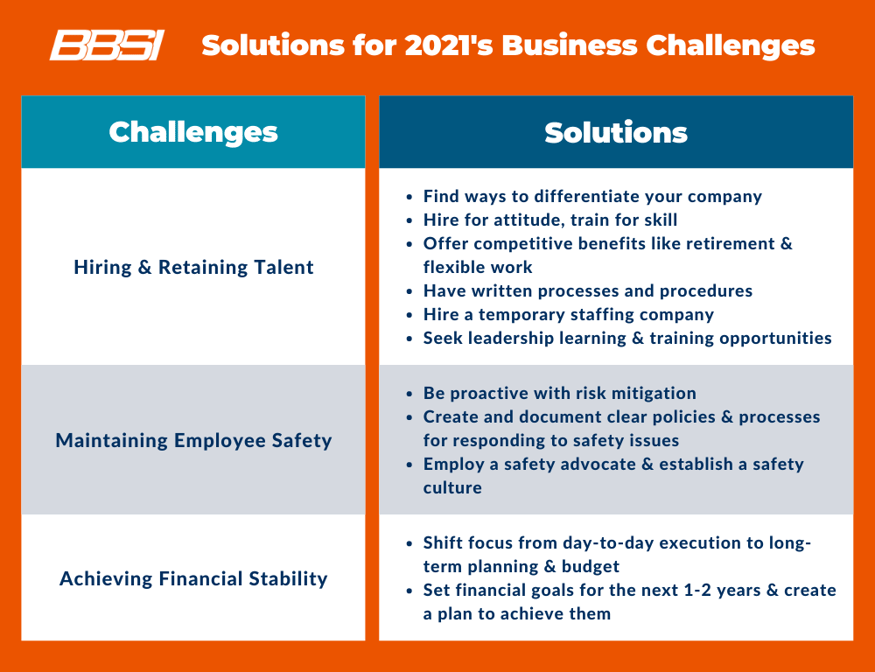
Ask a Business Unit: What Initiatives Should You Prioritize in 2022?
Expertise provided by:
- Cari Angle, BBSI Payroll Specialist
- Louie Maylad, BBSI Business Partner
- Shawn O'Brien, BBSI Risk Consultant
- Teresa Fonseca, BBSI Recruiting Specialist
While COVID-19’s impact was felt far and wide, it hit small and mid-sized businesses especially hard. We sat down with one of our Business Unit Teams to find out what were the biggest challenges their clients faced in 2021 and discussed the most important priorities business owners should focus on in 2022. Here’s what they had to say.
TABLE OF CONTENTS
A Look Back at 2021’s Business Challenges
Hiring and Retaining Talent
One of the most glaring challenges businesses faced was talent shortages. From burnout to financial constraints, heightened employee expectations, and “the great resignation”, businesses struggled to keep employees and staff their teams to meet market demands.
Managers and team leaders, who in the past were overseeing day-to-day operations and planning for the future, found themselves stepping back in to perform operational tasks and working alongside their employees.
Talent shortages also highlighted the inefficiencies that existed in businesses’ hiring processes. Many companies have seen a significant rise in candidates “ghosting” them during the hiring process or even after they’d been hired. Businesses lost valuable time and money spent interviewing, negotiating, and onboarding new candidates who ultimately disappeared without a trace.
“People are the hot commodity right now and businesses are having trouble finding and keeping them,” says Cari Angle, BBSI Payroll Specialist. “It costs companies so much money to constantly hire and start the training process to have someone then ‘ghost them.’ It costs them money, time, and resources they, unfortunately, don't have right now.”
Supply Chain Issues
The pandemic was especially hard on the global supply chain. Businesses found it more difficult to source and buy raw materials, leaving them heavily reliant on their existing suppliers. Businesses of all sizes saw an increase in prices and lead times, directly impacting their production and ability to get their products to market. Stress fractures appeared between frontline businesses and their suppliers, especially when it came to third-party contract manufacturers (TPMs).
While companies needed the ability to expand their manufacturing capacity when they couldn't meet demand, TPMs needed to meet that demand quickly and at scale with a limited amount of capacity.
While a lot remains up in the air, economists hope to see the supply of goods normalize in 2022.
Adjusting to Changing COVID Regulations and Maintaining Employee Safety
Though many companies had procedures around employee illness pre-COVID, the constantly changing regulations made it difficult for companies to navigate back-to-work guidelines and adjust procedures to create safe environments for employees.
A large part of the problem was that few companies had a culture that prioritized safety or employed safety advocates who were trained to identify risks and hazards and make suggestions accordingly. This general lack of awareness and understanding of what needed to be done often made it harder to comply with state and federal rules regarding worker safety during the pandemic.
Companies also found they lacked the processes for adjusting to new and amended regulations, as well as changes in the interpretation of existing laws.
Businesses found themselves trying to bring their workforces back together without jeopardizing their employees’ safety or the business in the process.
What Operational Weaknesses Did These Challenges Uncover?
The challenges businesses faced in 2021 uncovered some significant operational weaknesses in workplaces across the country. Here are some common mistakes businesses should be careful to avoid in 2022:
Reactivity, Not Proactivity
Business leaders across the board took a reactive approach to the COVID-19 pandemic. This pandemic has shown that proactivity is critical, not just in workplace safety, but throughout all business operations. Of course, that isn't to say all leaders reacted poorly. In retrospect, it's clear that few people expected how much the pandemic would affect the economy and businesses, so most weren't ready to deal with the fallout.

Lack of Strong Recruitment Processes and Backlogs of Quality Candidates
The pandemic exposed weaknesses in many companies' recruitment processes. Many companies, especially small and medium-sized businesses, didn’t have processes in place to deal with sudden employee turnover.
“The pandemic highlighted that a lot of companies don’t have the bench strength or a strong recruitment process in case something like COVID happens,” says Louie Maylad, BBSI Business Partner. “When the well dried up, they didn't have any other options.”
Finding quality candidates can be challenging, and many business leaders weren’t aware of the gaps in their recruiting processes that slowed their time to hire.
Inability to Meet Candidate Expectations
It has become clear in today’s job market that candidates have more power than ever before. Talent shortages have created more competition for high-quality candidates, giving job seekers more leverage in negotiating salary and benefits than before the pandemic. Business leaders must improve their benefit offerings, pay scale, and overall company culture to meet the demands of today’s talent pool.
The pandemic also shifted workforce priorities, increasing demand for better work-life balance. Businesses hiring in today's job market will likely need to offer a wider range of employment options, especially in terms of flexible hours and workplace locations. It's possible that today’s job market will need to include many more opportunities for remote work with accompanying implications for childcare, school commitments, and more.
“Candidates have changed. Their mindset and their expectations aren’t the same anymore. It's all about the people and what they want. It's not about what companies want anymore,” says Teresa Fonesca, BBSI Recruiting Specialist. “Candidates actually want to interview the companies, now. They can pick and choose who they want to work for.”
Lack of Clear Policies Related to COVID
Remember when people used to "push through" an illness and come to work anyway? The pandemic shined a light on many companies’ underdeveloped health and safety protocols, especially when it came to sick leave. Many companies have historically failed to provide sick leave benefits to their employees, even though that is one of the most important ways to protect others in the office from illness.
Business leaders have since scrambled to create clearer policies that address COVID-19, employees' concerns about being safe at work, and how to respond if they feel unwell. Many business leaders need to evaluate their current health protocols and policies, both to prepare for the return to work and for the possibility of future outbreaks.

Business Initiatives to Prioritize in 2022
There are many things that business leaders can do to be more proactive this year. Although we don't know what challenges lie ahead, the right priorities can help keep your company running smoothly as we move on from the pandemic. The most important priority is to assess what worked and what didn't during the pandemic and incorporate that information into your 2022 planning.
1. Focus on Employee Retention and Recruiting
Whether you create a product or offer a service, your employees are your biggest differentiator. Issues with recruiting and retention will inevitably trickle down into every other aspect of your business. Here’s how businesses can address staffing issues in the new year.
Find Ways to Differentiate Yourself to Potential Candidates
Be transparent with your employees about your company's goals and your intentions for hiring. Employees want to know you value and appreciate their contributions to the company. Can you afford to offer signing bonuses upon the successful completion of a 90-day probation period? Can you offer a better salary or offer improved benefits than your competitors? These are some of the factors that can help you stand out in today’s job market.
“In my 41 years of being in HR, culture has always been in the conversation, but it's never been as highlighted as it is now,” says Nelson Porras, BBSI Human Resources Consultant. “You can get the people, but if you don't keep them and make the culture comfortable for them, they're going to go to the next company that does treat them well. It's all about how you take care of your employees.”
Hire for Attitude; Train for Skill
The hiring process needs to be as streamlined as possible in order to keep costs down and to make sure you're able to hire high-quality talent quickly. When business owners decide to hire someone new, they should work to recruit and hire the best person based on attitude and experience, rather than pure skill.
“I always tell our clients here, hire for attitude and train for skill. Of course, they need a little bit of skill, but you can always teach them. Everybody can be taught skills, but you can't teach attitude,” says Porras.
Offer Retirement Benefits
Going into 2022, employees rank a competitive retirement program as among their most valued employer benefits. With more than half of Americans fearing they won’t have enough money to have a secure retirement, businesses need to offer retirement benefits to stay competitive in the hiring landscape. In some states such as California, Illinois, and Oregon, businesses are required to offer a retirement plan or the state-sponsored option. While retirement has always been important to employees, the financial impact of COVID-19 has made it more critical than ever.
2. Hire a Temporary Staffing Service
Hiring a temporary staffing service is a faster and more efficient way for companies to solve their workforce needs with temporary, temp-to-hire, or direct hire options available. Most staffing companies will have a network of experienced employees that meet the right criteria for your short- or long-term needs.
“I'm a firm believer that companies need to budget in a temporary staffing service. They can use it as temp-to-hire temporarily to buy them time until they find someone who might meet the right criteria for the position, or they could go through direct hire,” says Fonesca.
If you already utilize a staffing service, consider cross-training your talent as a way to make the most of your existing placements. It can take time to train new employees, so having someone who is familiar with your organization and can be trained to fulfill more duties is a great asset.
3. Be Proactive About Safety
Business leaders should establish safety protocols and procedures to help mitigate risk and prevent safety incidents that hurt a company’s culture and bottom line. While safety programs should be comprehensive and cover a variety of risks such as fall protection or hazard communication, strong COVID protocols will also remain critical.
Concerned about risk mitigation? Contact a BBSI Risk & Safety Consultant today.

One topic that should always remain a priority for businesses is implementing programs that keep its employees safe and healthy.
“The one thing that every business can control is keeping their employees safe and healthy. That's also how you retain employees,” says Sean O’Brien, BBSI Risk Management Consultant. “My biggest goal is to get every single one of our clients to understand they have a function in [their safety culture]. They can’t be reactive when they have an injury.”
Going into 2022, business owners should prioritize the “three Cs” of safety:
- Connection: Business owners and upper management need to be engaged in the safety process, essentially becoming their own safety advocates. They should participate in safety conversations that include everyone in the organization, whether in the office, at home, or at other locations. By staying in touch with their boots on the ground, management will understand what safety challenges they face.
- Communication: The business must communicate its safety expectations, processes, and goals effectively throughout the organization.
- Culture: Leadership, and the ability to set standards for safety and procedures, defines the culture of an organization. Leaders need to be available to create a supportive environment to listen to employees and make changes. This doesn’t mean managers have to be safety experts, but it does mean they need to understand the importance of safety for their employees and be proactive about workplace hazards and injuries.
Your employees need to know you're doing everything you can to maintain a safe work environment.
4. Establish Written Procedures and Protocols
The best way to ensure your company doesn't repeat the mistakes of 2021 is to develop clear written policies and protocols. Creating a dedicated employee handbook is an excellent way to accomplish this.
“In 2022, we'll be focusing on creating a handbook with our clients. It’s a great little tool that they can have to set expectations of the employee and the employer, and let everyone know what page they're on, so to speak,” says Angle.
Your documented policies should be relevant and referenced often to ensure legal compliance, set standards, and establish clear procedures for how your leaders should handle different situations.
“Establishing [policies] helps you put the carriage back where it needs to go, which is behind the horse rather than in front of it,” says O’Brien.
5. Seek Learning and Training Opportunities
Creating a habit of life-long learning is critical for business leaders and employees alike. In 2022, business owners should aim to learn new skills and look for ways to improve their business processes to move their company ahead of the competition.
“For 2022, owner engagement is critical. They need to make a strong effort to find learning opportunities, go to leadership trainings, and challenge themselves,” says O’Brien. “They know how to run a business as far as understanding the daily tasks. It's the other part of running a business they need to focus on and that’s learning how to be a better leader for their personnel.”
Some great opportunities for professional leadership development are:
- Investing in e-learning courses focused on leadership development
- Attending conferences that teach interpersonal skills and communication
- Starting a leadership mentoring program for employees
- Joining networking groups to learn from and share with other leaders
Effective leaders never stop learning. Taking opportunities to better yourself will only serve your business and your ability to achieve your goals.
6. Plan for Future Financial Health
Focusing too much on day-to-day survival can turn into a self-fulfilling prophecy. While it can be difficult to shift from dealing with the fires of the day to preventing the fires of tomorrow, or the next quarter, you can inadvertently put your business in a bad spot if you don’t dedicate time to your long-term financial planning. Business owners should prioritize looking at their longer-term financial health in 2022.
“A lot of our business owners just live day-to-day. They see what they have in the bank now. But the question is, ‘How do I increase what I have in the bank for next year?’,” says Maylad. “Everything is going up, the cost of goods is going up. The cost of labor is going up. So that’s really critical for our business owners to stay in business.”
The economic ramifications of the pandemic are likely to have a continued impact this year. As the cost of doing businesses increases, leaders will need to take a deeper dive into their budgeting to ensure they stay balanced when things get rocky. Business owners should set financial goals for the next one to two years, and create a plan for getting there.
Do you have the right people in place to get things done? Should you cut back on overtime and hire more people so you pay less money in payroll? These are the types of questions you should ask yourself as you create your plan.
7. Don't Try to Do Everything In-House
There's no reason to try to do everything discussed above by yourself. Hiring a support network like a PEO can help you shift your focus to long-term initiatives that will set your business up for success. While individual consultants can get pricey, an all-encompassing team like BBSI could be a great fit for your business and budget.
According to a survey conducted by the National Association of PEOs (NAPEO), businesses that had PEOs during the pandemic were:
- 58 percent less likely to have shut down permanently
- 32 percent less likely overall to have been negatively impacted by the pandemic
BBSI’s people and professional experience can make a huge impact on the success of your business. Each of our professional consultants brings experience from their previous careers as HR professionals, risk and safety managers, small business owners, and payroll specialists, allowing them to advise you in difficult situations as if they were in your shoes.
“Our people are what makes us different,” says Porras. “We can read regulations till we're blue in the face, but how we interpret it to our clients and present it to them with experiences we've had in our previous lives, helps them understand it better.”
Working with BBSI is more like having trusted advisors than having consultants. When our teams build relationships with our clients, they truly become part of their teams.
Reach out to a branch near you today to learn how we can help you reach your goals in 2022.
Disclaimer: The contents of this white-paper/blog have been prepared for educational and information purposes only. Reference to any specific product, service, or company does not constitute or imply its endorsement, recommendation, or favoring by BBSI. This white-paper/blog may include links to external websites which are owned and operated by third parties with no affiliation to BBSI. BBSI does not endorse the content or operators of any linked websites, and does not guarantee the accuracy of information on external websites, nor is it responsible for reliance on such information. The content of this white-paper/blog does not provide legal advice or legal opinions on any specific matters. Transmission of this information is not intended to create, and receipt does not constitute, a lawyer-client relationship between BBSI, the author(s), or the publishers and you. You should not act or refrain from acting on any legal matter based on the content without seeking professional counsel.